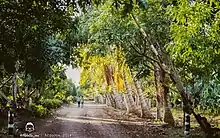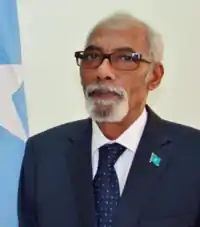Rahanweyn
The Rahanweyn (Maay: Reewin, Somali: Raxanweyn, Arabic: رحنوين), also known as the Digil and Mirifle is a major Somali clan. The clan resides in rich fertile lands in southern Somalia and lives on the banks of Somalia's two major rivers, the Shebelle and Jubba. The Rahanweyn are mainly concentrated in the southwestern regions of Bay, Bakool, and Lower Shabelle, but are also found in adjacent regions such as Mogadishu, Gedo, Lower Juba, and Middle Juba. They are also found in the Somali Region of Ethiopia and the North Eastern Province of Kenya.[1]
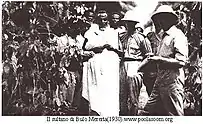
| Regions with significant populations | |
|---|---|
| Languages | |
| Af-Maay | |
| Religion | |
| Islam (Sunni) | |
| Related ethnic groups | |
| Hawiye, Dir clan, Isaaq, Darod and other Somali people |
Each of the two subclans of Rahnaweyn comprises a great number of clans and sub-clans.[2] They are also present in neighbouring counties such as Kenya and Ethiopia.
Overview
The Digil sub-clan mainly consists of farmers and coastal people, while the Mirifle are predominantly nomadic pastoralists.
According to constitutional law, Somalis are linguistically grouped into Mai Terreh and Maxaa Tiri. The vast majority of the Somalis who speak Mai Terreh (also known as Mai-Mai or Af-Maay) are the Rahanweyn, while the speakers of Maxaa Tiri (i.e. Standard Somali) belong to other clans (Darod, Dir, Hawiye and Isaaq).
History
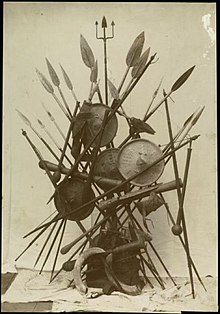
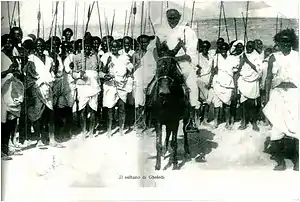
Antiquity
The Rahanweyn clan were mentioned as the people of Reewin who lived in the fertile lands and coastal provinces and were very wealthy and powerful people during the antiquity period in southern Somalia. They were said to be a sub group of Barbara or Barbaroi people ancestors of the Somali people.
Reewin groups were the first Somali/Cushitic group to enter what is the southern part of modern - day Somalia , around the end of the second century B.C [3]
Tunni Sultanate
The Tunni Sultanate (r. 9th century - 13th century) was a Somali Muslim Sultanate located in southwestern Somalia, south of the Shabelle river. It was ruled by the Tunni Rahanweyn people, who spoke the Af-Tunni (a dialect of Somali). The historical Tunni area correspondence to modern-day Lower Shabelle region[4] Barawa founded by a Tunni saint called Aw-Ali and became the new capital for the Tunni Sultanate. The town prospered and became one of the major Islamic centers in the Horn, the Barawaani Ulama, attracting students from all over the region. Muslim scholars of that time, such as Ibn Sa'id, wrote about Barawa as "an Islamic island on the Somali coast." Al-Idrisi also described the construction of the coral houses and noted that Barawa was full of both domestic and foreign commodities.[5] The Ajuran would take over the region and end the Tunni Sultanate.
Ajuran Sultanate
Along with Hawiye, Rahanweyn clan also came under the Ajuran Empire control in the 13th century that governed much of southern Somalia and eastern Ethiopia, with its domain extending from Hobyo in the north, to Qelafo in the west, to Kismayo in the south.[6]
Geledi Sultanate
At the end of the 17th century, the Ajuran Sultanate was on its decline, and various vassals were now breaking free or being absorbed by new Somali powers. One of these powers was the Geledi Sultanate which was established by Ibrahim Adeer a former Ajuran general that successfully pushed the imperial Ajuran army out of Afgooye. He subsequently established the Geledi sultanates ruling house, the Gobroon dynasty, after having first defeated the Ajuran vassal state, the Silcis Kingdom.
Geledi Sultanate was a Rahanweyn Kingdom ruled by the noble Geledi clan which controlled the entire Jubba River and extending parts of Shebelle River and dominating the East African trade. The Geledi Sultanate had enough power to force the southern Arabians to pay tribute to the noble Geledi Rulers like Ahmed Yusuf (Gobroon).[7]
Administration and military
The Sultanate of Geledi exerted a strong centralized authority during its existence and possessed all of the organs and trappings of an integrated modern state: a functioning bureaucracy, a hereditary nobility, titled aristocrats, a taxing system, a state flag, as well as a professional army.[8][9] The great sultanate also maintained written records of their activities, which still exist.[10]
The Geledi Sultanate's main capital was at Afgooye where the rulers resided in the grand palace. The kingdom had a number of castles, forts and other variety of architectures in various areas within its realm, including a fortress at Luuq and a citadel at Bardera.[11]
The Geledi army numbered 20,000 men in times of peace, and could be raised to 50,000 troops in times of war.[12] The supreme commanders of the army were the Sultan and his brother, who in turn had Malaakhs and Garads under them. The military was supplied with rifles and cannons by Somali traders of the coastal regions that controlled the East African arms trade.
Trade
The kingdom maintained a vast trading network, trading with Arabia, Persia, India, Near East, Europe and the Swahili World, dominating the East African trade, and was a regional powers.[13]
In the case of the Geledi, wealth accrued to the nobles and to the Sultanate not only from the market cultivation which it had utilized from the Shebelle and Jubba valleys but also trade from their involvement in the slave trade and other enterprises such as ivory, cotton, iron, gold, and among many other commodities. Generally, they also raised livestock animals such as cattle, sheep, goats, and chicken.[14]
Modern
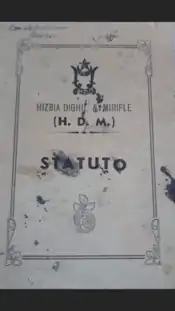
The Geledi Sultanate was eventually incorporated into Italian Somaliland Protectorate in 1908 by the Geledi ruler: Osman Ahmed who signed multiple treaties with the Italian colonials and the Kingdom ended with the death of Osman Ahmed in 1910.[15]
Hizbi Dhigil & Mirifle
The Hizbi Dhigil & Mirifle (1947–1969) was a Somali political party formed by members of the Rahanweyn clan that was among the first to call for Federalism in Somalia. It had its roots in the 1920s as the Hizbiya Dastur Mustaqil Al Sumal which was formed as an anti colonial organization that educated the inter riverine peoples and provided health and other charitable motions. Later the Hizbi Dhigil & Mirifle formed in 1947 and would be the main opposition party winning the 2nd most seats in parliament after the Somali Youth League. Its main goals were to advocate for the Digil and Mirifle peoples of Somalia and a true census of the Somali Republic. The party also pushed for improving agricultural and animal husbandry practices.[16]
Civil War and South West State
At the turn of 1991 when the Somali central government collapsed, the Rahanweyn clan formed their own autonomous state known as South West State of Somalia which was able to establish its own government, economy, army and flag. The Southwest state was able to successfully keep the stability in southern Somalia.[17][18]
Clan tree
The following listing is taken from the World Bank's Conflict in Somalia: Drivers and Dynamics from 2005 and the United Kingdom's Home Office publication, Somalia Assessment 2001.[19][20]
- Rahanweyn

In the south central part of Somalia the World Bank shows the following clan tree:[21]
- Rahanweyn
- Digil
- Geledi
- Jiddo
- Begedi
- Shanta-Alen
- Digil
Christian Bader lists the principal Digil and Rahanweyn subclans as follows:[22]
- Sab
- Amarre
- Daysame
- Digil
- Maad
- Rahanweyn
- Jambaluul
- Midhifle
- Begedi
- Aleemo
- Maatay
- Irroole
- Dabarre
- 'Ali Jiidu
- Dubdheere
- Waraasiile
- Tikeme
- Duubo
- Digiine
- Iise Tunni
- Rahanweyn
- Maad
- Digil
- Daysame
- Amarre
Notable Rahanweyn people
- Sharif Hassan, former speaker of Somali Parliament, former deputy Prime Minister and Finance Minister, first president of Southwest State of Somalia.
- Abbas Siraji, former Minister of Public Works and Reconstruction
- Abdulcadir Muhammed Aden, former Minister of Finance and leader of Hisbia Digil Mirifle
- Abdallah Deeroow, former Minister of Constitutional Affairs of the Transitional National Government
- Abdi Kusow, Professor of Sociology at Iowa State University
- Abdihakim Haji-Faqi, former Minister of Defence of Somalia
- Ibrahim Adeer first Sultan of the Geledi Sultanate
- Mahamud Ibrahim the second Sultan of Geledi and militarized the state, successfully repelled an Oromo invasion and Arab pirates
- Yusuf Mahamud Ibrahim 3rd Sultan of the Geledi presided over the Geledi golden age
- Ahmed Yusuf 4th Geledi sultan and powerful successor of Yusuf
- Osman Ahmed 5th and final Geledi Sultan and defeated both the Dervish and Ethiopian Empire in battle during his reign
- Abdullahi Haji Hassan Mohamed Nuur, former Foreign Minister of Somalia, and former Minister of Agriculture and Livestock
- Aden Madobe, former Speaker of the Parliament of the Transitional Federal Government, and former interim President of Somalia
- Hasan Shatigaduud, former chairman of the Rahanweyn Resistance Army, former Finance Minister, first President of Southwestern
- Mohamed Haji Mukhtar, professor of African and Middle Eastern History at Savannah State University
- Mohamed Ibrahim, former Minister of the Transitional National Government
- Mohamed Jawari, Speaker of the Federal Parliament of Somalia
- Mohamud Siraji, Member of Parliament and Chair of the Committee on Budget, Finance, Planning and Oversight of Government Financial institutions
- Mohamed Hamud, Minister of Defence of Somalia
- Muhammad Ibrahim Habsade, former rebel and Minister Agriculture in the Transitional Federal Government
- Mustafa Mohamed Moalim (Mustafa Maxamed Macalin), first fighter pilot in Somalia, Chief of Somali Air Force School and Chief of Somali Air
- Uways al-Barawi a very famous Islamic Saint and a religious leader who rebelled the Italians on the Benadir coast.
- Mohamed Abdinuur, Senior Statistician at the Somalia National Bureau of Statistics.
- Sheikh Mukhtar Mohamed Hussein, former Speaker of Parliament and interim President of Somalia
- Sheikh Mukhtar Robow Mansur,former member and spokesman for Al Shabaab and now leading his own group in the south west Somalia forest
- Osman Ibrahim, Former deputy minister of labor and social affairs and current deputy minister of mater and energy
Notes
- "Report of the Nordic fact-finding mission to the Gedo region in Somalia" (PDF). July 1999.
- Allen, James De Vere (1993). Swahili Origins: Swahili Culture & the Shungwaya Phenomenon. J. Currey. ISBN 978-0-85255-075-5.
- The Invention of Somalia Page 93
- Mukhtar, Mohamed Haji (25 February 2003). Historical Dictionary of Somalia. p. 50. ISBN 9780810866041.
- Mukhtar, Mohamed Haji (25 February 2003). Historical Dictionary of Somalia. p. 50. ISBN 9780810866041.
- Lee V. Cassanelli, The shaping of Somali society: reconstructing the history of a pastoral people, 1600-1900, (University of Pennsylvania Press: 1982), p.102.
- Luling (2002), p. 272.
- Horn of Africa, Volume 15, Issues 1-4, (Horn of Africa Journal: 1997), p.130.
- Michigan State University. African Studies Center, Northeast African studies, Volumes 11–12, (Michigan State University Press: 1989), p. 32.
- Sub-Saharan Africa Report, Issues 57-67. Foreign Broadcast Information Service. 1986. p. 34.
- S. B. Miles, On the Neighbourhood of Bunder Marayah, Vol. 42, (Blackwell Publishing on behalf of The Royal Geographical Society (with the institute of British Geographers): 1872), pp. 61–63.
- Transactions of the Bombay Geographical Society ..by Bombay Geographical Society p. 392
- Somali Sultanate: The Geledi City-state Over 150 Years - Virginia Luling (2002) p. 155
- Nelson, Harold (1982). "The Society and its Environment". Somalia, a Country Study. ISBN 9780844407753.
- Mukhtar, Mohamed Haji (25 February 2003). Historical Dictionary of Somalia. p. 210. ISBN 9780810866041. Retrieved 2014-02-15.
- Mukhtar, Mohamed Haji (25 February 2003). Historical Dictionary of Somalia. p. 106. ISBN 9780810866041.
|access-date=requires|url=(help) - "SOMALIA: RRA sets up autonomous region". IRIN. 1 April 2002. Archived from the original on 29 July 2013. Retrieved 2007-02-04.
- "Third autonomous region breaks with Somalia". Afrol News. 2 March 2002. Retrieved 2007-02-04.
- Worldbank, Conflict in Somalia: Drivers and Dynamics, January 2005, Appendix 2, Lineage Charts, p. 55 Figure A-1
- Country Information and Policy Unit, Home Office, Great Britain, Somalia Assessment 2001, Annex B: Somali Clan Structure Archived 2011-07-16 at the Wayback Machine, p. 43
- Worldbank, Conflict in Somalia: Drivers and Dynamics, January 2005, Appendix 2, Lineage Charts, p. 56 Figure A-2
- Bader, Christian (1999). "Genealogies Somali". Le sang et le lait: brève histoire des clans somali [Blood and milk: A brief history of the Somali clans] (in French). Paris: 9782706813733. p. 246. ISBN 2706813733. Retrieved 2010-03-09.
References
- Rebuilding Somalia: issues and possibilities for Puntland. HAAN Associates. 2001. ISBN 1-874209-04-9.

